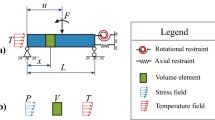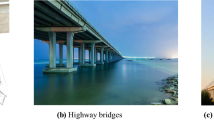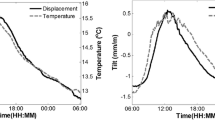Abstract
Considering environmental factors such as temperature in structural health monitoring progress has been a consensus. However, the uncertainty of monitoring data usually makes it difficult. In this paper, the uncertainty factor has been introduced into the anomaly diagnosis process, a Markov chain-Monta Carlo (MCMC) anomaly diagnosis method based on temperature-induced response has been proposed. First, a novel diagnosis index has been developed based on the temperature data and static strain response data collected by the SHM system, the MCMC process is used to analyze the diagnosis index, and the posterior frequency distribution histogram of the actual diagnosis index is obtained. Finally, by analyzing the histogram of an unknown state and the initial state (baseline state) of the structure, the anomaly probability of the unknown condition is obtained, which can be used for anomaly probability diagnosis of components. The availability of the method is evaluated by a laboratory truss structure test under a series of working conditions and is verified by field monitoring data of a hanger roof structure. The results show that the method can make better use of the temperature effect of the structure for anomaly diagnosis, and the uncertainty is well considered.
























Similar content being viewed by others
References
Xue SD (2020) Recent development and engineering practice of spatial structures in China. Steel Constr (Chinese & English) 35(7):1–16. https://doi.org/10.13206/jgjgSE20041904
Sun H, Di S, Du Z et al (2021) Application of multisynchrosqueezing transform for structural modal parameter identification. J Civ Struct Health Monit 11:1175–1188. https://doi.org/10.1007/s13349-021-00500-0
Ye X, Huang P, Pan C et al (2021) Innovative stabilization diagram for automated structural modal identification based on ERA and hierarchical cluster analysis. J Civ Struct Health Monit 11:1355–1373. https://doi.org/10.1007/s13349-021-00514-8
Sunca F, Ergün M, Altunişik AC et al (2021) Modal identification and fatigue behavior of Eynel steel arch highway bridge with calibrated models. J Civ Struct Health Monit 11:1337–1354. https://doi.org/10.1007/s13349-021-00512-w
Lorenzoni F, De Conto N, da Porto F et al (2019) Ambient and free-vibration tests to improve the quantification and estimation of modal parameters in existing bridges. J Civ Struct Health Monit 9:617–637. https://doi.org/10.1007/s13349-019-00357-4
Cao J, Zhang S, Liu Y (2021) Probabilistic SDDLV method for localizing damage in bridges monitored within one cluster under time-varying environmental temperatures. J Civ Struct Health Monit. https://doi.org/10.1007/s13349-021-00524-6
Sarmadi H, Entezami A, Salar M (2021) Bridge health monitoring in environmental variability by new clustering and threshold estimation methods. J Civ Struct Health Monit 11:629–644. https://doi.org/10.1007/s13349-021-00472-1
Sadhu A, Goli G (2017) Blind source separation-based optimum sensor placement strategy for structures. J Civ Struct Health Monit 7:445–458. https://doi.org/10.1007/s13349-017-0235-6
João PS, Cremona C, André D et al (2015) Static-based early-damage detection using symbolic data analysis and unsupervised learning methods. Front Struct Civ Eng 9(1):1–16. https://doi.org/10.1007/s11709-014-0277-3
Eun HC, Park SY, Lee MS (2013) Static-based damage detection using measured strain and deflection data. Appl Mech Mater 256–259:1097–1100. https://doi.org/10.1007/s11709-014-0277-3
El-Sisi AEDA, El-Husseiny OM, Matar EB et al (2020) Field-testing and numerical simulation of vantage steel bridge. J Civ Struct Health Monit 10:443–456. https://doi.org/10.1007/s13349-020-00396-2
Cocking S, Alexakis H, DeJong M (2021) Distributed dynamic fibre-optic strain monitoring of the behaviour of a skewed masonry arch railway bridge. J Civ Struct Health Monit 11:989–1012. https://doi.org/10.1007/s13349-021-00493-w
Sun F, Hoult NA, Butler LJ et al (2021) Distributed monitoring of rail lateral buckling under axial loading. J Civ Struct Health Monit. https://doi.org/10.1007/s13349-021-00504-w
Han QH, Ma Q, Xu J et al (2021) Structural health monitoring research under varying temperature condition: a review. J Civ Struct Health Monit 11:149–173. https://doi.org/10.1007/s13349-020-00444-x
Duan YF, Li Y, **ang YQ (2011) Strain-temperature correlation analysis of a tied arch bridge using monitoring data. In: 2011 international conference on multimedia technology. IEEE, Piscataway, pp 6025–6028. https://doi.org/10.1109/ICMT.2011.6002979
Alexakis H, Lau FDH, DeJong MJ (2021) Fibre optic sensing of ageing railway infrastructure enhanced with statistical shape analysis. J Civ Struct Health Monit 11:49–67. https://doi.org/10.1007/s13349-020-00437-w
Ding Y, Li AQ (2011) Assessment of bridge expansion joints using long-term displacement measurement under changing environmental conditions. Front Struct Civ Eng 5(3):37–380. https://doi.org/10.1007/s11709-011-0122-x
Baraccani S, Palermo M, Gasparini G (2021) A time domain approach for data interpretation from long-term static monitoring of historical structures. Struct Control Health Monit 28:e2708. https://doi.org/10.1002/stc.2708
**a Q, Zhou LM, Zhang J (2018) Thermal performance analysis of a long-span suspension bridge with long-term monitoring data. J Civ Struct Health Monit 8:543–553. https://doi.org/10.1007/s13349-018-0299-y
**a Q, Zhang J, Tian YD (2017) Experimental study of thermal effects on a long-span suspension bridge. J Bridge Eng 22(7):4017034. https://doi.org/10.1061/(ASCE)BE.1943-5592.0001083
Kulprapha N, Warnitchai P (2012) Structural health monitoring of continuous prestressed concrete bridges using ambient thermal responses. Eng Struct 40:20–38. https://doi.org/10.1016/j.engstruct.2012.02.001
Yarnold MT (2013) Temperature-based structural identification and health monitoring for long-span bridges. Dissertation, Drexel University.
Yarnold MT, Franklin LM, Aktan AE (2015) Temperature-based structural identification of long-span bridges. J Struct Eng 141(11):04015027. https://doi.org/10.1061/(ASCE)ST.1943-541X.0001270
Yarnold MT, Fl M (2015) Temperature-based structural health monitoring baseline for long-span bridges. Eng Struct 86:157–167. https://doi.org/10.1016/j.engstruct.2014.12.042
Murphy B, Yarnold MT (2018) Temperature-driven structural identification of a steel girder bridge with an integral abutment. Eng Struct 155:209–221. https://doi.org/10.1016/j.engstruct.2017.10.074
Lyu M, Zhu X, Yang Q (2017) Connection stiffness identification of historic timber buildings using temperature-based sensitivity analysis. Eng Struct 131:180–191. https://doi.org/10.1016/j.engstruct.2016.11.012
Kromanis R, Kripakaran P (2014) Predicting thermal response of bridges using regression models derived from measurement histories. Comput Struct 136(2014):64–77. https://doi.org/10.1016/j.compstruc.2014.01.026
Kromanis R (2015) Structural performance evaluation of bridges: characterizing and integrating thermal response. Dissertation, University of Exeter
Kromanis R, Kripakaran P (2016) SHM of bridges: characterising thermal response and detecting anomaly events using a temperature-based measurement interpretation approach. J Civ Struct Health Monit 6(2):237–254. https://doi.org/10.1007/s13349-016-0161-z
Kromanis R, Kripakaran P (2021) Performance of signal processing techniques for anomaly detection using a temperature-based measurement interpretation approach. J Civ Struct Health Monit 11:15–34. https://doi.org/10.1007/s13349-020-00435-y
**a Q, Cheng YY, Zhang J et al (2016) In-service condition assessment of a long-span suspension bridge using temperature-induced strain data. J Bridge Eng 22(3):4016124. https://doi.org/10.1061/(ASCE)BE.1943-5592.0001003
Diao Y, Sui Z, Guo K (2021) Structural damage identification under variable environmental/operational conditions based on singular spectrum analysis and statistical control chart. Struct Control Health Monit 28:e2721. https://doi.org/10.1002/stc.2721
Tu JQ, Tang ZF, Yun CB (2021) Guided wave-based damage assessment on welded steel I-beam under ambient temperature variations. Struct Control Health Monit 28:e2696. https://doi.org/10.1002/stc.2696
Chen DS, Xu WC, Qian HL et al (2020) Effects of non-uniform temperature on closure construction of spatial truss structure. J Build Eng. https://doi.org/10.1016/j.jobe.2020.101532
Xu WC, Chen DS, Qian HL et al (2021) Non-uniform temperature field and effects of large-span spatial truss structure under construction: field monitoring and numerical alanalysis. Struct 29:416–426. https://doi.org/10.1016/j.istruc.2020.11.014
Zhou M, Fan JS, Liu YF et al (2020) Non-uniform temperature field and effect on construction of large-span steel structures. Automat Constr 119:103339. https://doi.org/10.1016/j.autcon.2020.103339
Zhou M, Fan JS, Liu YF et al (2020) Analysis on non-uniform temperature field of steel grids of Bei**g Daxing international airport terminal building core area considering solar radiation. Eng Mech 37(5):46-54/73. https://doi.org/10.6052/j.issn.1000-4750.2019.07.0374 (in Chinese)
Luo YZ, Mei YJ, Shen YB et al (2013) Measurement and analysis of steel structure temperature and stress in National Stadium. J Build Struct 34(11):24–32. https://doi.org/10.14006/j.jzjgxb.2013.11.005 (in Chinese)
Hu YD, Hou RR, **a Q et al (2018) Temperature-induced displacement of supertall structures: a case study. Adv Struct Eng 22(4):982–996. https://doi.org/10.1177/1369433218795288
Sohn H, Dzwonczyk M, Straser EG et al (1999) An experimental study of temperature effect on modal parameters of the Alamosa Canyon Bridge. Earthq Eng Struct Dyn 28(8):879–897. https://doi.org/10.1002/(sici)1096-9845(199908)28:8%3c879::aid-eqe845%3e3.0.co;2-v
**a Q, Tian YD, Cai DX (2020) Structural flexibility identification and fast-Bayesian-based uncertainty quantification of a cable-stayed bridge. Eng Struct 214:110616-1-110616–11. https://doi.org/10.1016/j.engstruct.2020.110616
Xu M, Guo J, Wang S (2021) Structural damage identification with limited modal measurements and ultra-parse Bayesian regression. Struct Control Health Monit 28:e2729. https://doi.org/10.1002/stc.2729
Wang YW, Ni YQ, Zhang QH (2021) Bayesian approaches for evaluating wind-resistant performance of long-span bridges using structural health monitoring data. Struct Control Health Monit 28:e2699. https://doi.org/10.1002/stc.2699
Wang XY, Hou R, **a Y et al (2020) Laplace approximation in sparse Bayesian learning for structural damage detection. Mech Syst Signal Pr 140:106701. https://doi.org/10.1016/j.ymssp.2020.106701
Wang XY, Li L, Beck JL et al (2021) Sparse Bayesian factor analysis for structural damage detection under unknown environmental conditions. Mech Syst Signal Pr 154(11):107563. https://doi.org/10.1016/j.ymssp.2020.107563
Hou R, Wang XY, **a Q et al (2020) Sparse Bayesian learning for structural damage detection under varying temperature conditions. Mech Syst Signal Pr 145:106965. https://doi.org/10.1016/j.ymssp.2020.106965
Wang X, Hou R, **a Y et al (2020) Structural damage detection based on variational Bayesian inference and delayed rejection adaptive Metropolis algorithm. Struct Health Monit 20(4):147592172092125. https://doi.org/10.1177/1475921720921256
Huang T, Schroeder KU (2020) Bayesian probabilistic damage characterization based on a perturbation model using responses at vibration nodes. Mech Syst Signal Pr 139:106444. https://doi.org/10.1016/j.ymssp.2019.106444
Huang T, Schrder KU (2021) IWSHM 2019: Perturbation-based Bayesian damage identification using responses at vibration nodes. Struct Health Monit 20(3):942–959. https://doi.org/10.1177/1475921720985143
Alkam F, Lahmer T (2021) Eigenfrequency-based Bayesian approach for damage identification in catenary poles. Infrastruct. https://doi.org/10.3390/infrastructures6040057
Cantero-Chinchilla S, Malik MK, Chronopoulos D et al (2021) Bayesian damage localization and identification based on a transient wave propagation model for composite beam structures. Compos Struct 267:113849. https://doi.org/10.1016/j.compstruct.2021.113849
Barron RF, Barron BR (2011) Design for thermal stresses. Wiley, New Jersey. https://doi.org/10.1002/9781118093184:416-460
Price R (2003) An essay towards solving a problem in the doctrine of chances. Resonance 8(4):80–88. https://doi.org/10.1007/10.1007/BF02883540
Hastings WK (1970) Monte Carlo sampling methods using Markov chains and their applications. Biometrika 57(1):97–109. https://doi.org/10.2307/2334940
Metropolis N, Rosenbluth AW, Rosenbluth MN (1953) Equation of state calculations by fast computing machines. J Chem Phys 1(6):1087–1092. https://doi.org/10.1063/1.1699114
Dutta A, Mckay M, Kopsaftopoulos F et al (2021) Statistical residual-based time series methods for multicopter fault detection and identification. Aerosp Sci Technol 112(1):106649. https://doi.org/10.1016/j.ast.2021.106649
Sarmadi H, Yuen KV (2020) Early damage detection by an innovative unsupervised learning method based on kernel null space and peak-over-threshold. Comput-Aided Civ Inf 36(9):1150–1167. https://doi.org/10.1111/mice.12635
Vidya SR (2018) Verification of the applicability of the Gaussian mixture modelling for damage identification in reinforced concrete structures using acoustic emission testing. J Civ Struct Health Monit 8:395–415. https://doi.org/10.1007/s13349-018-0284-5
Said SE, Dickey DA (1984) Testing for unit roots in autoregressive-moving average models of unknown order. Biometrika 3:599–607. https://doi.org/10.2307/2336570
Acknowledgements
The authors would like to thank the support from The Joint Funds of the National Natural Science Foundation of China (U1939208), National Natural Science Foundation of China (No. 51525803) and the 111 Project (B20039).
Author information
Authors and Affiliations
Corresponding author
Additional information
Publisher's Note
Springer Nature remains neutral with regard to jurisdictional claims in published maps and institutional affiliations.
Rights and permissions
About this article
Cite this article
Xu, J., Liu, M., Ma, Q. et al. Temperature-based anomaly diagnosis of truss structure using Markov chain-Monte Carlo method. J Civil Struct Health Monit 12, 705–724 (2022). https://doi.org/10.1007/s13349-022-00572-6
Received:
Revised:
Accepted:
Published:
Issue Date:
DOI: https://doi.org/10.1007/s13349-022-00572-6




